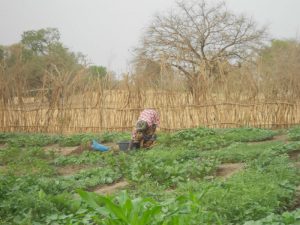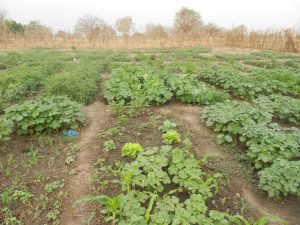Location
Timbindallah, Department of Velingara, Senegal
Community Description
Timbindallah is a farming community of around 900 people, composed of Pulaar and Soninke ethnic groups. The Pulaars are known for keeping cows, and they do not disappoint this stereotype in this community.
Corn, millet, sorghum, and peanuts are abundantly harvested, yet those harvests are eaten up by the time the rains come to start a new year of farming. People have little experience gardening, and therefore the diet is lacking essential vitamins and minerals.
 There is one French school in the community with two classes, and any further educational opportunities must be sought elsewhere. Many fathers employ their children’s labor at the house or in the fields rather than sending them to school. Many children attend the Koranic school in the village.
There is one French school in the community with two classes, and any further educational opportunities must be sought elsewhere. Many fathers employ their children’s labor at the house or in the fields rather than sending them to school. Many children attend the Koranic school in the village.
Tension exists between the two ethnic groups in terms of collaborating on projects, though there is no violence or disturbances.
The town is 4 kilometers from a larger cross-town, Manda, where a weekly market provides a place to buy and sell animals, vegetables, fruits, clothes, soap, etc.
The women of the village have prepared a garden space where they grow vegetables for their family consumption and to sell at the market. It is a piece of land that is filled with water in the rainy season, and therefore a place for gardening.
Another NGO built a well close to the site, 100 meters from the space. However, the number of women using the well puts it in danger of drying up. 130 women are involved in the garden, each holding one or two plots of 1 x 4 meters.
 The women grow okra and bissap as they are accustomed to, onions, lettuce, tomatoes, and are interested in any and all vegetables they can grow to feed their families, and to sell at the weekly market in Manda. The distance of the current well, and the horrible traffic jam in the evening, leaves this garden on the cusp between thriving and failing.
The women grow okra and bissap as they are accustomed to, onions, lettuce, tomatoes, and are interested in any and all vegetables they can grow to feed their families, and to sell at the weekly market in Manda. The distance of the current well, and the horrible traffic jam in the evening, leaves this garden on the cusp between thriving and failing.
The women’s husbands and sons built a stick fence to keep the cows and goats out, and the women are involved in planting a live fence for the future. They are hard-working and aware of the nutritional benefits of gardening.
Project Description
This project is to build a well at the women’s garden in Timbindallah.
The water table for the well is 15 meters. However, the well will be dug at the driest part of the year to determine whether 15 meters is deep enough to pull water even at that time.
The well will be lined with wire fencing and cement. Women will draw water with a simple pulley system.
Although the water from the well will mostly be used for the women’s garden, it will be potable, and can be used for other purposes.
A top cover at the well will be installed in the future as funds permit. Also contemplated for the future will be a cement basin inside of the garden, with a tube to bring water closer to the women’s garden beds.
A well builder lives in a village about 3 km away from Timbindallah and can complete the project with the aid of the women’s young boys.
Water Charity funds will be used to pay for the cement and labor.
Project Impact
130 women, as well as about 500 members of their families, will benefit from the project.
Peace Corps Volunteer Directing Project
Ruth Nervig
Comments
The new well will serve the community by improving the success of the garden and reducing the work needed to produce crops. It will have a great impact on the health and well-being of the villagers by improving the nutrition of the families and providing them with economic benefits.
Dollar Amount of Project
$555.00
Donations Collected to Date
$555.00
Dollar Amount Needed
$0.00 – This project has now been fully funded through the generosity of friends and family of Peace Corps Volunteer Ruth Nervig.
We encourage others to continue to donate using the Donate button below, and we will notify Ruth of your donation. Additional funds will be used to fund the next project by Ruth and/or those of other PCVs in the country of service.
![]() This project has been finished. To read about the conclusion of the project, CLICK HERE.
This project has been finished. To read about the conclusion of the project, CLICK HERE.